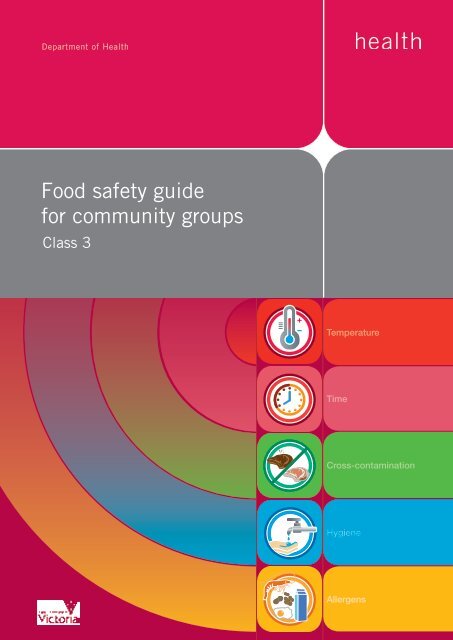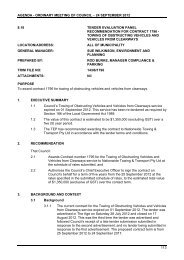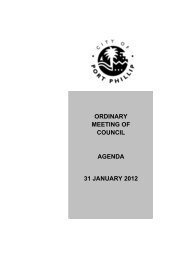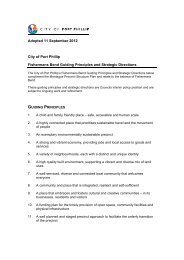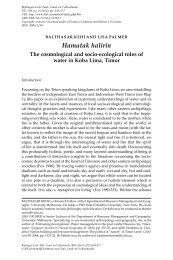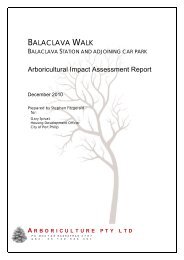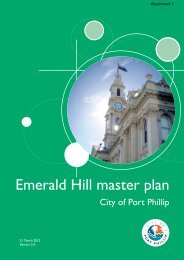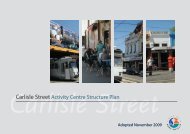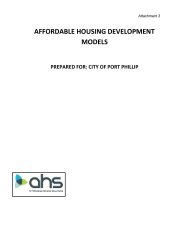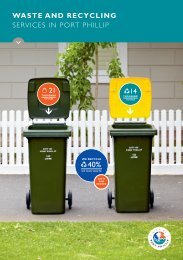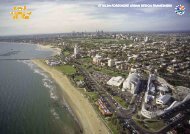Food Safety Guide for Community Groups - Class 3 - City of Port Phillip
Food Safety Guide for Community Groups - Class 3 - City of Port Phillip
Food Safety Guide for Community Groups - Class 3 - City of Port Phillip
You also want an ePaper? Increase the reach of your titles
YUMPU automatically turns print PDFs into web optimized ePapers that Google loves.
<strong>Food</strong> safety guide<br />
<strong>for</strong> community groups<br />
<strong>Class</strong> 3<br />
Temperature<br />
Time<br />
Cross-contamination<br />
Hygiene<br />
Allergens
<strong>Food</strong> safety guide <strong>for</strong><br />
community groups<br />
<strong>Class</strong> 3
If you would like to receive this publication in an accessible <strong>for</strong>mat, please<br />
phone 1300 364 352 using the National Relay Service 13 36 77 if required,<br />
or email: foodsafety@health.vic.gov.au<br />
This document is available in PDF <strong>for</strong>mat on the internet at:<br />
www.health.vic.gov.au/foodsafety<br />
Published by the Health Protection Branch, Victorian Government,<br />
Department <strong>of</strong> Health, Melbourne, Victoria.<br />
© Copyright, State <strong>of</strong> Victoria, Department <strong>of</strong> Health, 2011<br />
This publication is copyright, no part may be reproduced by any process except<br />
in accordance with the provisions <strong>of</strong> the Copyright Act 1968.<br />
Authorised by the State Government <strong>of</strong> Victoria, 50 Lonsdale Street, Melbourne.<br />
April 2011 (1010020)
Contents<br />
Introduction to food safety <strong>for</strong> community groups — <strong>Class</strong> 3 1<br />
<strong>Class</strong> 3 at a glance 3<br />
How can food become unsafe? 6<br />
How can my community group prepare safe food? 7<br />
Practices to keep food safe 9<br />
1: Purchasing or receiving food 10<br />
2: Storage 11<br />
3: Reheating pre-packaged food 13<br />
4: Cook and serve 14<br />
5: Serving cooked food 15<br />
6: Events and stalls 16<br />
Records 19<br />
Introduction to records 20<br />
Sheet C: <strong>Community</strong> group events <strong>of</strong> one to two days 22<br />
Record 1: Supplies 23<br />
Record 2: Cooking 24<br />
Record 3: Overnight cold storage 25<br />
Sheet D: <strong>Community</strong> group events <strong>of</strong> more than two days 26<br />
Record 1: Supplies 27<br />
Record 2: Cold storage 28<br />
Record 3: Hot storage 29<br />
Record 4: Temperature control 31
1<br />
Introduction to food safety <strong>for</strong> community<br />
groups — <strong>Class</strong> 3<br />
What is the purpose <strong>of</strong> this guide?<br />
<strong>Community</strong> groups have important legal obligations to ensure the safety <strong>of</strong> any food they sell.<br />
This guide will help your group understand its responsibilities under the <strong>Food</strong> Act 1984 and the steps to follow<br />
to ensure food safety. It is designed <strong>for</strong> your group if:<br />
• you sell food solely <strong>for</strong> the purposes <strong>of</strong> raising funds <strong>for</strong> charity or are not <strong>for</strong> pr<strong>of</strong>it body, and<br />
• you are classified as a class 3 food premises under the <strong>Food</strong> Act 1984, and<br />
• those handling the food are mostly volunteers.<br />
If a volunteer makes food at home and donates it <strong>for</strong> sale at a community fundraiser, that person is not selling<br />
the food.<br />
Whilst everyone is encouraged to handle food safely, volunteers do not need to register their homes as food<br />
premises with the council.<br />
Examples <strong>of</strong> community groups include local sporting clubs, senior citizens groups, and church groups.<br />
If your group does not match this definition, you have different legal responsibilities that are not covered in this<br />
guide. The Department <strong>of</strong> Health food safety website or your local council can advise you further on this.<br />
You need to know…<br />
The <strong>Food</strong> Act 1984 controls the sale <strong>of</strong> food in Victoria. Its main purpose is to protect people from food<br />
borne illness. The Act covers all community groups that sell food when raising funds <strong>for</strong> charity, or <strong>for</strong> a not<br />
<strong>for</strong> pr<strong>of</strong>it body.<br />
Under the Act, all food premises selling food in Victoria are classified according to their food safety risks.<br />
There are four classes — from highest risk (class 1) to lowest risk (class 4).<br />
Be<strong>for</strong>e you commence selling food, you must contact your local council to confirm your food premises<br />
classification as this decides your responsibilities under the Act.<br />
Different food safety steps must be followed <strong>for</strong> different food handling tasks. This is because some foods are<br />
more likely to cause food poisoning if the food is not handled properly.<br />
If your municipal council has confirmed that your activities fall within class 3, this guide provides practical<br />
in<strong>for</strong>mation, as well as the record sheets you must complete and keep onsite when you hold a food event.<br />
<strong>Class</strong> 3 not <strong>for</strong> pr<strong>of</strong>it bodies with paid staff<br />
If you are a not <strong>for</strong> pr<strong>of</strong>it organisation and most <strong>of</strong> your food handlers are paid staff, this guide is not relevant to<br />
your activities. Use <strong>Class</strong> 3 minimum records sheet A or B to keep records <strong>of</strong> your activities. They are available<br />
on the Department <strong>of</strong> Health website.<br />
Free online food handler training<br />
Any one handling food at your events is encouraged to complete the free online learning program,<br />
d<strong>of</strong>oodsafely, to improve their knowledge <strong>of</strong> safe food handling. It is available at<br />
http://d<strong>of</strong>oodsafely.health.vic.gov.au<br />
1
1<br />
<strong>Class</strong> 3 premises can do class 4 activities<br />
All class 3 food premises can also do any class 4 activities, as these are lower risk than class 3. Your premises<br />
will still fall within class 3 — not class 4 — because your classification is based on your highest risk food<br />
handling activities. This is explained in this guide.<br />
Choice to limit activities to class 4<br />
On the other hand, your organisation can choose to limit its activities to class 4. In this way, you benefit from<br />
the simpler food safety requirements that apply to class 4 food premises. If you wish to change to class 4,<br />
contact your council to discuss what’s involved.<br />
Where can l get more help?<br />
When it comes to food safety, your local council environmental health <strong>of</strong>ficer is your best source <strong>of</strong> advice:<br />
• speak with an Environmental Health Officer from your council<br />
The Department <strong>of</strong> Health <strong>Food</strong> <strong>Safety</strong> Unit can also help with advice and resources:<br />
• Call the <strong>Food</strong> <strong>Safety</strong> Hotline: 1300 364 352<br />
• Visit the <strong>Food</strong> <strong>Safety</strong> website at www.health.vic.gov.au/foodsafety<br />
• Download, or ask your council <strong>for</strong> the flyer <strong>Food</strong> fundraisers which explains ‘food premises classification’<br />
under Victoria’s <strong>Food</strong> Act 1984, and the different types <strong>of</strong> food handling activities that classes 2, 3 and 4<br />
food premises may carry out<br />
• Visit d<strong>of</strong>oodsafely — a free online food handler learning program at http://d<strong>of</strong>oodsafely.health.vic.gov.au<br />
2
2<br />
<strong>Class</strong> 3 at a glance<br />
This section summarises the different types <strong>of</strong> class 3 food handling activities typically run by community<br />
groups. If your group is running ‘cook and serve’ food events, it explains some additional rules that apply to<br />
these events. It also introduces the records community groups must keep <strong>of</strong> their food handling activities.<br />
<strong>Class</strong> 3 community food premises and activities<br />
Under the <strong>Food</strong> Act, market stalls, food vans, community halls, sporting group kiosks and permanent premises<br />
are all called food premises.<br />
As a class 3, you may also carry out any class 4 food activities.<br />
This table lists the type <strong>of</strong> class 3 and class 4 food handling activities that your community group can carry out.<br />
<strong>Food</strong> activity type<br />
Selling low-risk foods –<br />
pre-packaged or<br />
unpackaged<br />
Selling packaged cakes<br />
Selling pre-packaged<br />
high-risk foods<br />
Re-heating and selling<br />
pre-packaged foods<br />
Other lower risk activities<br />
Simple sausage sizzles<br />
Cooking and serving<br />
high-risk foods immediately<br />
Examples<br />
✔ Biscuits<br />
✔ Carbonated beverages<br />
✔ Cereals<br />
✔ Confectionery<br />
✔ Dried fruits<br />
✔ Fruit, whole or cut<br />
✔ Jams<br />
✔ Grains<br />
✔ Ice creams, except s<strong>of</strong>t serve<br />
✔ Tea and c<strong>of</strong>fee, with or without milk or soymilk<br />
✔ Vegetables<br />
✔ All cakes, including cakes with cream fillings<br />
✔ Desserts, such as cheesecakes and custard tarts<br />
✔ Fruit salads<br />
✔ Meats, including poultry and game<br />
✔ Meals, such as fresh pasta, casseroles, curries and lasagne<br />
✔ Sandwiches<br />
✔ Smallgoods (such as Strasbourg, ham and chicken loaf), smoked salmon,<br />
s<strong>of</strong>t cheeses, and dips)<br />
✔ Pies or sausage rolls, heated but still in original packaging<br />
✔ Sale <strong>of</strong> eggs in the shell<br />
✔ <strong>Food</strong> tastings (a sample <strong>of</strong> high-risk food <strong>of</strong>fered <strong>for</strong> up to 4 hours)<br />
✔ Wine tastings, including served with cheese or low-risk foods<br />
✔ Sausages, onions, sauce and bread only, cooked and served straight away<br />
Selling high-risk foods at an event <strong>of</strong> no more than two days at any one time:<br />
✔ Barbeques including hamburgers, sausages, other meats, or eggs all<br />
cooked and served immediately<br />
3
2<br />
What is high-risk food?<br />
The term ‘high-risk food’ is used throughout this guide. It means food that is potentially hazardous — that is<br />
food that has to be kept at certain temperatures to minimise the growth <strong>of</strong> any harmful bacteria that may be<br />
present in the food. For the purposes <strong>of</strong> this guide, it includes all food other than low-risk food.<br />
High-risk foods need to be handled carefully to keep them safe. If something goes wrong during the food<br />
handling process, harmful bacteria may grow and multiply and food can quickly become unsafe to eat.<br />
High-risk foods can include meat, seafood, poultry, eggs, dairy products and smallgoods, or foods that<br />
contain these, <strong>for</strong> example sandwiches, quiche and prepared salads.<br />
Other foods can become high-risk after they are cooked, such as noodles, rice, pasta and similar foods.<br />
You will find more in<strong>for</strong>mation, including a full list <strong>of</strong> class 3 and class 4 activities, on the Department <strong>of</strong><br />
Health website at www.foodsmart.vic.gov.au/foodclass, or by contacting the environmental health <strong>of</strong>ficer<br />
at your local council.<br />
Can we sell any other foods?<br />
Your community group may carry out any type <strong>of</strong> food handling, or increase the number <strong>of</strong> days you operate at<br />
events, as long as you meet the food safety requirements that apply to the relevant food premises class. This is<br />
a choice <strong>for</strong> your organisation. But you must make sure you have council approval under the <strong>Food</strong> Act <strong>for</strong> the<br />
food activities you plan to run.<br />
Your council environmental health <strong>of</strong>ficer can give you more in<strong>for</strong>mation about your options.<br />
Why a two-day limit on ‘cook and serve’ food events?<br />
‘Cook and serve’ events are those where food is cooked at the site to be eaten straight away — <strong>for</strong> example<br />
a one to two day barbeque involving hamburgers, or any other meats, or eggs which are all cooked and<br />
served immediately.<br />
As most class 3 food activities are low-risk, only simple precautions are usually needed to keep these foods<br />
safe. Cook and serve food activities are the exception because there is more chance <strong>of</strong> harmful bacteria<br />
multiplying and causing illness associated with these activities.<br />
For this reason, different requirements apply to cook and serve events depending on their duration.<br />
If your group wishes to keep its classification as class 3, and your food handling activities take place <strong>for</strong><br />
more than two days at any one time, the only cook and serve activity you may carry out at the site involves<br />
sausages that are cooked and served immediately, with or without onions, bread and sauce. This is because<br />
<strong>of</strong> the greater risks <strong>of</strong> high-risk foods, such as hamburgers.<br />
You can also conduct any <strong>of</strong> the other food handling activities listed on page 3.<br />
The two-day restriction only applies to cook and serve food events.<br />
4
2<br />
What if we change the type <strong>of</strong> food we sell?<br />
If you have been classified as class 3, and you plan to alter the type <strong>of</strong> food you sell to include higher risk<br />
activities (such as unpackaged high-risk foods, <strong>for</strong> example uncooked meats, small goods, sandwiches), you<br />
must notify council as this will change your food premises classification. It will also alter the type <strong>of</strong> records and<br />
other requirements that apply to the group’s activities.<br />
For example, your activities will be class 2 if you wish to sell foods that are:<br />
• cooked, then stored (<strong>for</strong> instance in a bain-marie) and served hot later, or<br />
• cooked, then stored under refrigeration and reheated and served later (such as curries or other meals<br />
prepared the night be<strong>for</strong>e, stored in the refrigerator and reheated at the event).<br />
These foods need refrigeration during the food handling process – including throughout cooking and storage<br />
— to keep them safe.<br />
Contact your council environmental health <strong>of</strong>ficer if you are not sure or need further in<strong>for</strong>mation.<br />
What records do we need to keep as a class 3?<br />
Your community group must complete records about its food activities and keep them on site at your food events.<br />
Keeping records will help you monitor your food safety and hygiene practices. In the event <strong>of</strong> a problem, your<br />
records will demonstrate that you did everything you should have done to keep food safe.<br />
Given the low food safety risks associated with class 3 activities, only simple records are needed.<br />
You will find all the record sheets at pages 19–32. The records vary depending on the type <strong>of</strong> food activities<br />
you plan to run.<br />
This guide will help you work out which records are specific to your activities.<br />
5
3<br />
How can food become unsafe?<br />
<strong>Food</strong> can be unsafe to eat if:<br />
• harmful bacteria are given the right conditions to grow and multiply (certain high-risk foods need to be<br />
handled carefully to keep them safe)<br />
• food is contaminated by raw high-risk foods or by unhygienic handling<br />
• substances contaminate food (<strong>for</strong>eign materials such as dirt, dust, hair, glass or stones)<br />
• other things may also contaminate foods (such as insects, rodents, chemicals, detergents<br />
or cleaning substances).<br />
The risk <strong>of</strong> food prepared by your community group becoming unsafe will depend on how and where food is<br />
stored, prepared and handled by volunteers and staff members.<br />
What are allergens and food intolerances?<br />
Allergens are foods known to cause reactions in allergic people due to an immune response. This can be life<br />
threatening. Allergens in foods must be clearly communicated to customers.<br />
In addition to food allergies, some people experience intolerance to certain foods. The most common causes<br />
<strong>of</strong> food allergic reactions or food intolerances are:<br />
• cereals containing gluten and their products (wheat, rye, barley, oats and spelt and their hybridised strains)<br />
• shellfish, crustaceans and their products<br />
• eggs and egg products<br />
• fish and fish products<br />
• milk and milk products<br />
• peanuts and soybeans, and their products<br />
• added sulphites in concentrations <strong>of</strong> 10 mg/kg or more (typically in dried fruits, s<strong>of</strong>t drinks and sausages)<br />
• tree nuts and sesame seeds and their products<br />
• any prepared foods that contain these ingredients.<br />
6
4<br />
How can my community group prepare safe food?<br />
The risk <strong>of</strong> food becoming unsafe will depend upon the types <strong>of</strong> food being prepared and how food is handled.<br />
The following icons will help you to focus on key food safety aspects when using this guide.<br />
Manage food temperature<br />
• The temperature danger zone <strong>for</strong><br />
bacteria growth is when cold food<br />
is kept above 5°C, and if hot food<br />
is stored below 60°C <strong>for</strong> significant<br />
amounts <strong>of</strong> time.<br />
• Limit the time high-risk food is kept<br />
in the temperature danger zone<br />
(5°C to 60°C).<br />
• Return food to the refrigerator<br />
during delays in food preparation.<br />
Avoid cross-contamination<br />
• Keep raw food separate from<br />
cooked and ready-to-eat food.<br />
• Store cooked food and ready-to-eat<br />
food above raw foods in the fridge.<br />
When you see this<br />
image pay attention to<br />
temperature control<br />
When you see this<br />
image pay attention to<br />
cross-contamination<br />
• Cook high-risk food to an internal<br />
temperature <strong>of</strong> 75°C or above.<br />
• Hot food must be kept at 60°C<br />
or hotter.<br />
• Cold food must be kept at 5°C<br />
or colder.<br />
• If food has been in the temperature<br />
danger zone <strong>for</strong> a total time <strong>of</strong><br />
four hours or longer, it must be<br />
thrown out.<br />
• Use separate utensils and cutting<br />
boards when preparing raw and<br />
cooked or ready-to-eat foods.<br />
• Protect food from dirt and dust<br />
or any other <strong>for</strong>eign materials or<br />
substances that may make food<br />
unsafe.<br />
Ensure good hygiene and cleaning standards<br />
• Store food away from contaminants<br />
and protect it from pests.<br />
• Use clean, sanitised and dry cutting<br />
boards, equipment and separate<br />
utensils.<br />
When you see this<br />
image pay attention to<br />
hygiene and cleaning<br />
• Wash hands thoroughly<br />
and regularly.<br />
• Keep floors, walls, ceilings<br />
and equipment clean.<br />
Be aware <strong>of</strong> allergens and intolerances<br />
• Store food away from potential<br />
allergen contaminants.<br />
• Make sure foods that can cause<br />
reactions are identifiable.<br />
Where you see this<br />
image pay attention<br />
to allergens and<br />
intolerances<br />
• Identify foods that commonly cause<br />
reactions and label or name them in<br />
stored and prepared foods.<br />
• Avoid allergens cross-contaminating<br />
other foods, prepare allergen free<br />
foods be<strong>for</strong>e foods that contain<br />
allergens and use clean equipment<br />
or equipment kept <strong>for</strong> allergen<br />
foods only.<br />
7
Practices to keep food safe<br />
1: Purchasing or receiving food<br />
2: Storage<br />
3: Reheating pre-packaged food<br />
4: Cook and serve<br />
5: Serving cooked food<br />
6: Events and stalls<br />
9
1<br />
Practices to keep food safe<br />
Purchasing or receiving food<br />
What should I do?<br />
Check that businesses or suppliers are aware <strong>of</strong> their<br />
food safety requirements and can demonstrate that<br />
to you.<br />
Ensure all purchased food is properly packaged and<br />
has not been damaged during transportation.<br />
Check that pre-packaged food is labelled and that<br />
unpackaged food has product in<strong>for</strong>mation.<br />
Why?<br />
Your suppliers, whether individuals or businesses,<br />
must supply you with safe food.<br />
To keep food safe from contamination during<br />
transportation.<br />
If food contains allergens you must provide<br />
customers with accurate in<strong>for</strong>mation.<br />
Check use-by dates on fresh foods.<br />
Check the temperature <strong>of</strong> food on arrival, ensuring<br />
cold food is 5°C or colder.<br />
What if something goes wrong?<br />
To check how food should be stored, and when it<br />
must be used by, so you can store it in date order.<br />
<strong>Food</strong> not kept at the right temperature can become<br />
unsafe as harmful bacteria may multiply and cause<br />
food poisoning.<br />
If food has become unsafe or may have been contaminated it may cause food poisoning or gastro illness.<br />
If you are unsure about the safety <strong>of</strong> certain foods, do not use them.<br />
Keeping the right records about supplies<br />
Your must keep the records in this guide (see page 20) to demonstrate compliance with food safety practices.<br />
The records you must keep depend on the kind <strong>of</strong> food handling activities you plan to run.<br />
Select the correct records <strong>for</strong> your food handling activities using the chart on page 21.<br />
10
2<br />
Storage<br />
Cold storage<br />
Types <strong>of</strong> storage What should I do? Why?<br />
Cold storage<br />
Check the temperature <strong>of</strong> cold<br />
storage units.<br />
Keep cold food at 5ºC or colder.<br />
<strong>Food</strong> not kept at the right temperature<br />
can become unsafe as harmful bacteria<br />
may multiply and cause food poisoning.<br />
Practices to keep food safe<br />
What if something goes wrong?<br />
Frozen food should be solid.<br />
Keep raw food separate from<br />
cooked food.<br />
Ensure cold storage units are<br />
cleaned regularly.<br />
If raw food comes into contact<br />
with cooked food it can cause<br />
cross-contamination and result in<br />
food poisoning.<br />
Dirty cold storage units can make<br />
food unsafe.<br />
If cold storage units are not keeping food at 5ºC you will need to adjust settings, contact a refrigerator<br />
technician, or add more ice to the cooler.<br />
If frozen food shows any signs <strong>of</strong> thawing, either continue thawing and use immediately, or discard.<br />
Throw out ready-to-eat food if you think it might have been contaminated.<br />
Keeping the right records about cold storage<br />
Your must keep the records in this guide (see page 20) to demonstrate compliance with food safety practices.<br />
The records you must keep depend on the kind <strong>of</strong> food handling activities you plan to run.<br />
Select the correct records <strong>for</strong> your food handling activities using the chart on page 21.<br />
11
2<br />
Practices to keep food safe<br />
Dry storage<br />
Types <strong>of</strong> storage What should I do? Why?<br />
Dry storage<br />
Keep all dry storage areas clean<br />
and pest free.<br />
Ensure packaged food that<br />
has been opened is stored<br />
in containers.<br />
Keep and attach labels to any<br />
packaged food that is repackaged.<br />
Storage areas must be kept clean<br />
to avoid attracting pests.<br />
To reduce the risk <strong>of</strong> spillage in dry<br />
storage and to help keep storage<br />
areas clean.<br />
In order to be able to identify the<br />
food and any ingredients that may<br />
cause allergic reactions or food<br />
intolerances.<br />
What if something goes wrong?<br />
<strong>Food</strong> may be unsafe to eat if storage conditions or packaging are unsuitable or if cross-contamination has<br />
occurred. If you are unsure if food has been contaminated or may be unsafe, do not use it.<br />
Throw away food that shows signs <strong>of</strong> pest damage.<br />
12
3<br />
Reheating pre-packaged food<br />
Pre-packaged foods, such as pies, pasties and sausage rolls, are sealed in a package be<strong>for</strong>e supply to you<br />
and remain in that package until sale.<br />
What should I do?<br />
Be careful to follow the reheating or cooking<br />
instructions on the packaging.<br />
Reheat the food quickly and thoroughly to kill food<br />
poisoning bacteria.<br />
Why?<br />
Harmful bacterial may have the right conditions to<br />
multiply and cause food poisoning if pre-packaged<br />
food is not thoroughly reheated.<br />
Practices to keep food safe<br />
Randomly select an item <strong>of</strong> food and measure the<br />
temperature <strong>of</strong> the thickest part <strong>of</strong> the food using<br />
a probe thermometer.<br />
When reheating, ensure food reaches 60ºC or hotter.<br />
Look at the reheated food to see that it is hot<br />
(steaming) all the way through.<br />
If the food is not hot (steaming) all the way through:<br />
• increase the reheating time or temperature,<br />
• reduce the portions <strong>of</strong> food being reheated,<br />
• review your reheating method, and/or<br />
• repair or replace equipment.<br />
To minimise the risk <strong>of</strong> food poisoning.<br />
To find out what is not right and take action to fix the<br />
problem be<strong>for</strong>e your food becomes unsafe.<br />
Keeping the right records<br />
For events <strong>of</strong> more than two days<br />
Your must keep the records in this guide (see page 20) to demonstrate compliance with food safety practices.<br />
The records you must keep depend on the kind <strong>of</strong> food handling activities you plan to run.<br />
Select the correct records <strong>for</strong> your food handling activities using the chart on page 21.<br />
13
4<br />
Practices to keep food safe<br />
Cook and serve events <strong>of</strong> one to two days maximum<br />
What should I do?<br />
Ensure cooked meats and foods containing meats<br />
are cooked to 75°C.<br />
Burgers and rissoles must be cooked thoroughly.<br />
Why?<br />
Meats need to be fully cooked right through to<br />
minimise the risk <strong>of</strong> food poisoning.<br />
Solid pieces <strong>of</strong> cutlets, steaks or roasts <strong>of</strong> red meat<br />
and oily fish can be cooked to preference.<br />
Cut burgers and rissoles in half and check that<br />
there is no pink meat in the middle.<br />
Ensure all high-risk foods are thoroughly cooked,<br />
<strong>for</strong> instance foods containing meat, dairy or other<br />
high-risk foods.<br />
Ensure that sauces, stews and soups are brought to<br />
the boil and are used or disposed <strong>of</strong> after one sitting.<br />
Ensure staff and volunteers wash their hands be<strong>for</strong>e<br />
commencing work and at regular intervals, especially<br />
when changing from raw to cooked food.<br />
Clean and sanitise all work surfaces and utensils.<br />
Keep separate preparation areas <strong>for</strong> raw and<br />
cooked food.<br />
Keep foods containing allergens separate from other<br />
foods, and use separate equipment <strong>for</strong> cooking<br />
foods with allergens if preparing food <strong>for</strong> allergen<br />
sensitive people.<br />
What if something goes wrong?<br />
<strong>Food</strong> not cooked thoroughly can become unsafe<br />
as harmful bacteria may have the right conditions to<br />
multiply and cause food poisoning and illness.<br />
Unclean hands can carry dirt and bacteria and make<br />
food unsafe.<br />
Dirty surfaces and equipment can make food unsafe.<br />
Cross-contamination can result in food poisoning and<br />
illness. Raw food can contaminate cooked food.<br />
Cross-contamination <strong>of</strong> foods with allergens<br />
can cause allergen-sensitive people to have a<br />
severe reaction.<br />
High-risk foods must be thoroughly cooked be<strong>for</strong>e being eaten. If in doubt, return to heat and cook further.<br />
Do not serve food that is not fully cooked.<br />
High-risk foods may be unsafe to eat if cross-contaminated by dirty equipment or poor handling.<br />
Keeping the right records<br />
Your must keep the records in this guide (see page 20) to demonstrate compliance with food safety practices.<br />
The records you must keep depend on the kind <strong>of</strong> food handling activities you plan to run.<br />
Select the correct records <strong>for</strong> your food handling activities using the chart on page 21.<br />
14
5<br />
Serving cooked food<br />
What should I do?<br />
Ensure staff and/or volunteers wash their hands<br />
be<strong>for</strong>e commencing work and then at regular<br />
intervals, especially when changing from raw to<br />
cooked food.<br />
Only use clean, sanitised and dry cutting boards,<br />
equipment and utensils.<br />
Why?<br />
Poor food handling practices can make food unsafe<br />
to eat and may cause illness.<br />
Dirty surfaces and equipment can make food unsafe.<br />
Practices to keep food safe<br />
Clean and sanitise all work surfaces and utensils<br />
be<strong>for</strong>e preparing food.<br />
Serve food immediately after cooking.<br />
Minimise the time cooked high-risk foods are kept at<br />
room temperature.<br />
Keep separate preparation areas <strong>for</strong> raw food and<br />
cooked food.<br />
Keep foods containing allergens separate from<br />
other foods.<br />
Ensure that you can provide accurate in<strong>for</strong>mation<br />
to people who are sensitive to food allergies<br />
and intolerances.<br />
What if something goes wrong?<br />
<strong>Food</strong> can become contaminated during long<br />
serving periods.<br />
Cross-contamination can result in food poisoning<br />
and illness. Raw food can contaminate cooked food<br />
and make it unsafe to eat.<br />
The wrong in<strong>for</strong>mation may cause some people who<br />
have eaten your food to become severely ill and<br />
suffer toxic shock.<br />
For more in<strong>for</strong>mation go to:<br />
www.health.vic.gov.au/foodsafety<br />
High-risk cooked foods may be unsafe to eat if storage conditions are unsuitable or if cross-contamination<br />
has occurred. If in doubt, do not use the food.<br />
<strong>Food</strong> can become unsafe if contaminated by dirty equipment, poor handling or when safe temperatures have<br />
not been maintained and service time has been longer than four hours.<br />
If food has been contaminated or not kept at safe temperatures, do not use it.<br />
15
6<br />
Practices to keep food safe<br />
Events and stalls<br />
Make sure that food provided at events is safe. Because some events take place in an open-air environment,<br />
the temperature can be unpredictable and contamination sources can be numerous.<br />
What should I do?<br />
Be<strong>for</strong>e events, check the availability <strong>of</strong> storage space<br />
and equipment at the event venue.<br />
If you are handling high-risk foods, be<strong>for</strong>e events<br />
check availability <strong>of</strong> power and/or backup power<br />
supply in case power is interrupted during the event.<br />
Take a kit to the event containing a temperature<br />
probe, cleaning agents and equipment and extra<br />
copies <strong>of</strong> records.<br />
Ensure food is covered and protected from<br />
contamination by customers, insects, rodents,<br />
dust, dirt, chemicals and other <strong>for</strong>eign materials<br />
or substances during transportation.<br />
Ensure all equipment is clean and sanitised<br />
be<strong>for</strong>e use.<br />
If you are handling unpackaged foods, check the<br />
availability, quality and volume <strong>of</strong> water supplies<br />
with the local council where the event will occur.<br />
Ensure food handlers working at the event are<br />
experienced in handling food safely.<br />
Check food temperatures throughout the event —<br />
on arrival, in storage and during cooking.<br />
Ensure staff and volunteers are aware <strong>of</strong> hygiene<br />
practices and the relevant practices to keep food safe.<br />
Check that your staff and volunteers are in<strong>for</strong>med<br />
<strong>of</strong> their responsibilities and that they understand<br />
what records must be kept and how to check<br />
food temperatures.<br />
Ensure staff and volunteers are able to provide<br />
accurate in<strong>for</strong>mation to customers about allergens<br />
and other substances in the foods you are providing<br />
at the event.<br />
Why?<br />
To keep food safe at the event you may need to<br />
make arrangements <strong>for</strong> additional equipment<br />
or storage.<br />
To keep cold foods safe during storage, preparation<br />
and serving you may need continuous access to<br />
refrigeration and power.<br />
To be able to check temperatures and thoroughly<br />
clean equipment.<br />
To avoid the likelihood <strong>of</strong> contamination.<br />
Unclean equipment can make food unsafe.<br />
If water is unsafe you will need to ensure safe water<br />
<strong>for</strong> handwashing and cleaning at the event by<br />
providing bottled water or an alternative water supply,<br />
or suitable hand sanitisers.<br />
Poor food handling practices can make food unsafe.<br />
To ensure food is kept safe, keep cold food at 5°C or<br />
colder and cooked hot food at 60°C or hotter.<br />
Poor hygiene practices can make food unsafe.<br />
Some aspects <strong>of</strong> the records in this guide are<br />
mandatory.<br />
You are required under the <strong>Food</strong> Act to keep these<br />
mandatory records.<br />
The <strong>Food</strong> Standards Code states that accurate<br />
in<strong>for</strong>mation must be available to customers about<br />
allergens and other substances in food being served<br />
(see page 6).<br />
What if something goes wrong?<br />
Dispose <strong>of</strong> food if you suspect it is not safe to eat, if it has not been safely handled or if you suspect it has<br />
been contaminated.<br />
If food has been in the temperature danger zone (see page 7) <strong>for</strong> a total time <strong>of</strong> four hours or longer, it must<br />
be thrown out.<br />
16
6<br />
Tip<br />
Provide staff and volunteers with in<strong>for</strong>mation about primary business contacts (such as the event coordinator<br />
or hire equipment contact) in case they need assistance on a food safety question during the event.<br />
A note about raw eggs<br />
Some eggs can be contaminated with bacteria. The department recommends that community groups do not<br />
serve desserts or any other foods that contain raw/uncooked eggs in the finished product, such as tiramisu<br />
and mousse, at community events. There is a higher risk <strong>of</strong> such foods causing food poisoning. For further<br />
in<strong>for</strong>mation, go to www.health.vic.gov.au/eggs/downloads/eggs_serviceindustry.pdf<br />
Practices to keep food safe<br />
This advice does not apply to cakes which — as is usually the case — contain cooked eggs, as thorough<br />
cooking will kill the bacteria.<br />
17
Records<br />
Sheet C: <strong>Community</strong> group events <strong>of</strong> one to two days<br />
Sheet D: <strong>Community</strong> group events <strong>of</strong> more than two days<br />
19
Introduction to records<br />
This section contains the record sheets you must use to meet the minimum record keeping requirements under<br />
Victoria’s food legislation.<br />
What records must I keep?<br />
The records you must keep depend on the kind <strong>of</strong> food handling activities you plan to run.<br />
Use the diagram on page 21 to work out which records are specific to your activities.<br />
You must keep the completed records <strong>for</strong> 12 months to demonstrate compliance with essential food<br />
safety practices.<br />
If your council requests them, you must also provide the council with a copy <strong>of</strong> your records.<br />
This is a legal requirement. If you are unclear about which records you should be keeping:<br />
• speak with an environmental health <strong>of</strong>ficer from your local council<br />
• call the <strong>Food</strong> <strong>Safety</strong> Hotline: 1300 364 352<br />
• visit the <strong>Food</strong> <strong>Safety</strong> website at www.health.vic.gov.au/foodsafety<br />
What is the purpose <strong>of</strong> records?<br />
Keeping records can help you:<br />
• monitor food safety and hygiene<br />
• in providing in<strong>for</strong>mation to other members <strong>of</strong> your organisation about their roles and responsibilities when<br />
working with food<br />
• demonstrate that you did everything you should have done in the event <strong>of</strong> a food safety problem.<br />
What do the records cover?<br />
Record Sheets C and D only apply to community groups where those handling the food are mostly volunteers.<br />
The records cover some essential food safety practices:<br />
• Supply <strong>of</strong> all food to your food premises<br />
• <strong>Food</strong>s cooked and served immediately<br />
• Cold storage <strong>of</strong> high-risk foods<br />
• Hot storage <strong>of</strong> high-risk foods<br />
• Temperature control <strong>of</strong> deliveries <strong>of</strong> high-risk foods.<br />
Tip — how many days is your event?<br />
The duration <strong>of</strong> your food event is important in working out which records you must keep. Is it one to two<br />
days, or more than two days at any one time?<br />
For some food handling activities an event taking place over one to two days will require different records to the<br />
same event running <strong>for</strong> more than two days.<br />
This is because some foods are more likely to cause food poisoning if the food is not handled properly —<br />
and the longer an event runs, the more chance there is <strong>for</strong> something to go wrong.<br />
The diagram on page 21 will help you choose the right records <strong>for</strong> your activities.<br />
20
Keeping the right records<br />
Your must keep the records in this guide to demonstrate compliance with food safety practices.<br />
The records you must keep depend on the kind <strong>of</strong> food handling activities you plan to run.<br />
Select the correct records <strong>for</strong> your activities using the chart below.<br />
Answer the questions in the chart to work out which <strong>of</strong> the class 3 minimum record sheets in this guide must<br />
be completed <strong>for</strong> your food premises. This will ensure that you keep the right records.<br />
Event duration?<br />
If you will be handling food at the premises or location <strong>for</strong>:<br />
One to two days maximum at any one time<br />
At a market stall or any other premises (such as<br />
a sports club kiosk, or the occasional use <strong>of</strong> a<br />
community hall or van)<br />
More than two days at any one time<br />
At any food premises, including the use <strong>of</strong> a fixed<br />
food premises on an ongoing basis, market stalls<br />
or food vans<br />
Use Record Sheet D<br />
Use Record Sheet C<br />
Record 1: Supplies<br />
Record 2: Cooking on site<br />
Record 3: Overnight cold storage <strong>of</strong> high-risk<br />
foods, between day one and day two<br />
Record 1: Supplies<br />
Record 2: Cold storage <strong>of</strong> high-risk foods<br />
Record 3: Reheating pre-packaged<br />
high-risk foods<br />
Record 4: Temperature control <strong>of</strong> deliveries<br />
<strong>of</strong> high-risk foods to premises from suppliers<br />
(eg to a kiosk)<br />
You only need to complete a record if you handle food as described in the flow chart above.<br />
If you are unsure about which records to complete, contact your council <strong>for</strong> advice.<br />
More copies <strong>of</strong> the record sheets are available from your local council or the Department <strong>of</strong> Health website at<br />
www.health.vic.gov.au/foodsafety/guide/classification.htm#class3.<br />
21
<strong>Class</strong> 3 food premises minimum records<br />
Sheet C: <strong>Community</strong> group events <strong>of</strong> one to two days<br />
Record 1: Supplies<br />
Record 2: Cooking<br />
Record 3: Overnight cold storage<br />
All food businesses and community groups are required by law to ensure the food they sell is safe to eat.<br />
To demonstrate compliance with essential food safety practices, you must keep the records in this guide that<br />
apply to the food handling activities at your community events.<br />
You must keep the completed records <strong>for</strong> 12 months. If requested, you must also provide a copy <strong>of</strong> your<br />
records to the local council.<br />
This is a legal requirement. 1<br />
Different records apply to different activities. There are three different records in this set.<br />
• Record 1 always applies. You must complete it <strong>for</strong> every food event.<br />
• Read the introduction to Records 2 and 3 to work out when you need to complete these records.<br />
These record sheets apply regardless <strong>of</strong> where the community group conducts its event — it can be at a<br />
market stall, a food van, or at a building that it owns, leases or which it has permission to use from time to time<br />
(such as a community hall). They apply whether the food handling activity is infrequent, or occurs on a regular<br />
basis (such as every weekend during a sporting season).<br />
The record sheets also contain useful tips <strong>for</strong> how to make the most <strong>of</strong> the random checks <strong>of</strong> food temperature<br />
and cooking processes.<br />
1 Section 19CB and clause 5 <strong>of</strong> the declaration <strong>of</strong> minimum records (“the declaration”). The declaration is available at http://www.gazette.<br />
vic.gov.au/gazette/Gazettes2010/GG2010S241.pdf. A food premises is classified under the Act according to the highest risk activity<br />
undertaken at the premises. Many <strong>of</strong> the activities listed in this guide make a premises a “class 3 food premises”. However, a class 3 food<br />
premises can also engage in lower risk activities (that apply to class 4 premises). In such a case the premises falls within class 3 — not 4.<br />
<strong>Class</strong> 3 minimum records, sheet C: Version 1, July 2010 © Copyright Department <strong>of</strong> Health 2010<br />
22
<strong>Class</strong> 3 minimum records — sheet C<br />
<strong>Community</strong> group one to two day events<br />
Record 1: Supplies<br />
You must keep the following records about the supply <strong>of</strong> all food to the food premises. 2, 3<br />
Record <strong>of</strong> food suppliers<br />
• You must keep all receipts and invoices that are received from a supplier. Usually this will be purchases<br />
made <strong>for</strong> food to be sold at the community group’s premises. It also includes any deliveries to the group’s<br />
food premises. 3<br />
• It is optional to complete the COMMENTS section below to record where these receipts are stored.<br />
However by writing this down it will assist you if you need to show the receipts, if the council requests them.<br />
Comments<br />
Please make additional copies if required.<br />
2 Clause 1 <strong>of</strong> the declaration, and clauses 1(d) and 2 <strong>of</strong> schedule 1 <strong>of</strong> that declaration.<br />
3 ‘Supply’ means the supply <strong>of</strong> food to a food premises from another food premises or another person. It does not include the supply <strong>of</strong> food —<br />
• to a temporary food premises (such as a stall or occasional use <strong>of</strong> a hall) or a mobile food premises (such as a food van), and<br />
• from another food premises (<strong>of</strong> whatever kind), and<br />
• if the supplying and the receiving premises are both operated by the same proprietor/community group.<br />
<strong>Class</strong> 3 minimum records, sheet C: Version 1, July 2010 © Copyright Department <strong>of</strong> Health 2010<br />
23
<strong>Class</strong> 3 minimum records — sheet C<br />
<strong>Community</strong> group one to two day events<br />
Record 2: Cooking<br />
This record must only be kept if potentially hazardous food 4 is cooked on site with the intention <strong>of</strong> being<br />
served immediately. This record does not apply to the heating <strong>of</strong> food such as packaged pies or sausage rolls. 5<br />
Instruction:<br />
• The mandatory requirement is to record the results <strong>of</strong> a random check that has been done once during<br />
the event to verify whether potentially hazardous food is thoroughly cooked. It is also recommended that<br />
this random check be conducted early on the first day to ensure that should any corrective action be<br />
required it is undertaken early in the event.<br />
Verification that food is<br />
thoroughly cooked.<br />
Mandatory random check that<br />
the food is fully cooked.<br />
Recommended additional<br />
random check that food is<br />
fully cooked.<br />
Tips:<br />
YES<br />
<br />
<br />
Corrective action<br />
If food is not fully cooked record what corrective action was taken<br />
to make sure it is fully cooked be<strong>for</strong>e being sold to consumers<br />
(such as continued cooking or when food is rechecked).<br />
• <strong>Class</strong> 3 community groups are encouraged to use the additional recommended random check section<br />
<strong>of</strong> this record if the event runs <strong>for</strong> two days (use second check on day two) or if there is a changeover <strong>of</strong><br />
volunteers. This provides additional verification that the cooking procedure used ensures that the food sold<br />
is thoroughly cooked.<br />
• The recommended method <strong>of</strong> checking food is thoroughly cooked is to cut a burger patty or steak in half<br />
and make sure there is no pink meat. For soups use a probe thermometer to check that the temperature<br />
exceeds 75°C or bring to boil.<br />
• It may be useful to record the name <strong>of</strong> the person who has checked cooked food in the ‘corrective action’<br />
section above in case verification is required.<br />
Please make additional copies if required.<br />
4 Potentially hazardous food is defined on page 4.<br />
5 Clause 4 <strong>of</strong> the declaration, and clause 2 <strong>of</strong> schedule 3 <strong>of</strong> that declaration.<br />
<strong>Class</strong> 3 minimum records, sheet C: Version 1, July 2010 © Copyright Department <strong>of</strong> Health 2010<br />
24
<strong>Class</strong> 3 minimum records — sheet C<br />
<strong>Community</strong> group one to two day events<br />
Record 3: Overnight cold storage<br />
This record must only be kept if potentially hazardous food is to be kept in cold storage overnight, be<strong>for</strong>e<br />
the second day <strong>of</strong> a two-day event. It applies whether the food is to be —<br />
(a) sold in packaging; or<br />
(b) cooked and served immediately. 6<br />
Temperature rules:<br />
• Frozen foods should always be delivered and kept frozen hard (unless being defrosted)<br />
• For food kept in cold storage, maintain the temperature at 5°C or below<br />
Date<br />
Description <strong>of</strong> each<br />
cold storage unit<br />
For example, fridge at Bruce<br />
Jones’ place.<br />
Temperature <strong>of</strong> food<br />
item chosen<br />
Randomly select an item <strong>of</strong><br />
food stored overnight (<strong>for</strong> the<br />
second day) and measure<br />
the temperature<br />
Corrective action<br />
If selected food item does not meet the above<br />
temperature rules what did you do to ensure it<br />
complies? For example, change fridge settings,<br />
or move food to another fridge or discard food.<br />
Please make additional copies if required.<br />
6 Clause 4 <strong>of</strong> the declaration, and clause 1 <strong>of</strong> schedule 3 <strong>of</strong> that declaration.<br />
<strong>Class</strong> 3 minimum records, sheet C: Version 1, July 2010 © Copyright Department <strong>of</strong> Health 2010<br />
25
<strong>Class</strong> 3 food premises minimum records<br />
Sheet D: <strong>Community</strong> group events <strong>of</strong> more<br />
than two days<br />
Record 1: Supplies<br />
Record 2: Cold storage<br />
Record 3: Hot storage<br />
Record 4: Temperature control<br />
All food businesses and community groups are required by law to ensure the food they sell is safe to eat.<br />
To demonstrate compliance with essential food safety practices, you must keep the records in this guide<br />
that apply to the food handling activities at your community events.<br />
You must keep the completed records <strong>for</strong> 12 months. If requested, you must also provide a copy <strong>of</strong> your<br />
records to the local council.<br />
This is a legal requirement. 7<br />
There are four different records in this set.<br />
Different records apply to different activities.<br />
• Record 1 always applies. You must complete it <strong>for</strong> every food event.<br />
• Read the introduction to Records 2, 3 and 4 to work out when you need to complete these records.<br />
These record sheets apply regardless <strong>of</strong> where the community group conducts its event — it can be at a<br />
market stall, a food van, or at a building that it owns, leases or which it has permission to use from time to time<br />
(such as a community hall). They apply whether the food handling activity is infrequent, or occurs on a regular<br />
basis (such as every weekend during a sporting season).<br />
The record sheets also contain useful tips <strong>for</strong> how to make the most <strong>of</strong> the random checks <strong>of</strong> food temperature<br />
and cooking processes.<br />
7 Section 19CB and clause 5 <strong>of</strong> the declaration <strong>of</strong> minimum records (“the declaration”). The declaration is available at http://www.gazette.<br />
vic.gov.au/gazette/Gazettes2010/GG2010S241.pdf. A food premises is classified under the Act according to the highest risk activity<br />
undertaken at the premises. Many <strong>of</strong> the activities listed in this guide make a premises a “class 3 food premises”. However, a class 3 food<br />
premises can also engage in lower risk activities (that apply to class 4 premises). In such a case the premises falls within class 3 — not 4.<br />
<strong>Class</strong> 3 minimum records, sheet D: Version 1, July 2010 © Copyright Department <strong>of</strong> Health 2010<br />
26
<strong>Class</strong> 3 minimum records – sheet D<br />
<strong>Community</strong> group events more than two days<br />
Record 1: Supplies 89<br />
Instruction:<br />
You must keep a record about the details <strong>of</strong> all suppliers <strong>of</strong> all food to the food premises. 8,9<br />
The details include:<br />
• the type <strong>of</strong> food supplied to the premises that will be sold, or handled <strong>for</strong> sale, at the stall or other<br />
temporary premises. This is a general description only, such as condiments, cut fresh fruit, fresh<br />
vegetables, shell eggs, packaged cakes, and<br />
• the trading name <strong>of</strong> the supplier, and<br />
• the address and telephone number <strong>of</strong> the supplier.<br />
Provided the in<strong>for</strong>mation in this record is complete and up to date, each further instance <strong>of</strong> supply from the<br />
same supplier <strong>of</strong> the same types <strong>of</strong> listed food does not need to be re-recorded below.<br />
However, you must also keep all receipts and invoices that are received from a supplier. Usually this will<br />
be purchases made <strong>for</strong> food to be sold at the community group’s premises by members <strong>of</strong> the group —<br />
as well as any dockets received with deliveries made to the group’s food premises.<br />
Type <strong>of</strong> food<br />
Examples are<br />
condiments, fresh<br />
fruit, fresh vegetables<br />
Trading name <strong>of</strong> supplier<br />
(<strong>for</strong> example name <strong>of</strong> supermarket from<br />
which food is delivered or purchased)<br />
Address<br />
(Store location or warehouse)<br />
Contact<br />
phone<br />
number<br />
8 Clause 1, schedule 1 <strong>of</strong> the declaration.<br />
9 ‘Supply’ means the supply <strong>of</strong> food to a food premises from another food premises or another<br />
person (such as a farmer). However, it does not include the supply <strong>of</strong> food—<br />
• to a temporary food premises (such as a market stall or temporary use <strong>of</strong> a community hall)<br />
or a mobile food premises (such as a food van), and<br />
• from another food premises (<strong>of</strong> whatever kind), and<br />
• if the supplying and the receiving premises are both operated by the same proprietor/community group.<br />
<strong>Class</strong> 3 minimum records, sheet D: Version 1, July 2010 © Copyright Department <strong>of</strong> Health 2010<br />
27
<strong>Class</strong> 3 minimum records — sheet D<br />
<strong>Community</strong> group events more than two days<br />
Record 2: Cold storage<br />
This record must only be kept if potentially hazardous food 10 is to be kept in cold storage at food premises,<br />
if that premises operates <strong>for</strong> a period <strong>of</strong> more than two consecutive days at any one time. 11<br />
It is mandatory to record the results <strong>of</strong> a random check <strong>of</strong> each cold storage unit in use that is conducted<br />
once in each week in which the food premises operates.<br />
In the case <strong>of</strong> a temporary food premises (such as a market stall, or where the community group has<br />
permission to use a community hall), it is mandatory to record the results <strong>of</strong> a random check <strong>of</strong> each cold<br />
storage unit in use, conducted as follows:<br />
• once in each week that the premises is operating; and<br />
• <strong>for</strong> a stall or other activity that is operated <strong>for</strong> less than one week at any one time, once during each such<br />
period. (For example, if the stall is operated <strong>for</strong> blocks <strong>of</strong> three days with one cold storage unit, and this<br />
occurs 10 times a year, there would be 10 records <strong>for</strong> the year, with a record <strong>for</strong> each three-day period.)<br />
The temperature check will be relevant to pre-packaged potentially hazardous food including where it is<br />
intended that it will be heated and held hot prior to sale. 12<br />
Temperature rules:<br />
• Frozen foods should always be kept frozen hard (unless being defrosted)<br />
• For food kept in cold storage, maintain the temperature at 5°C or below<br />
Date Description Operating Temperature Corrective action<br />
<strong>of</strong> each cold temperature <strong>of</strong> food item If selected food item does not meet the above<br />
temperature rules what did you do to ensure it<br />
storage unit set <strong>for</strong> chosen<br />
complies? For example, change fridge settings,<br />
(<strong>for</strong> example, each cold Randomly select<br />
or move food to another fridge or discard food.<br />
LG fridge or esky)<br />
an item <strong>of</strong> food<br />
storage unit<br />
and measure<br />
the temperature<br />
Please make additional copies if required.<br />
10 Potentially hazardous food is defined on page 4.<br />
11 Clause 2, items 1 and 3 <strong>of</strong> schedule 2 <strong>of</strong> the declaration.<br />
12 It would also be relevant to sausages that are stored (which are to be cooked and served immediately).<br />
The random check can be <strong>of</strong> any potentially hazardous food stored.<br />
<strong>Class</strong> 3 minimum records, sheet D: Version 1, July 2010 © Copyright Department <strong>of</strong> Health 2010<br />
28
<strong>Class</strong> 3 minimum records — sheet D<br />
<strong>Community</strong> group events more than two days<br />
Record 3: Hot storage<br />
This record must only be kept if pre-packaged potentially hazardous food 13 is to be kept heated in hot<br />
storage prior to sale at a food premises, if that premises operates <strong>for</strong> a period <strong>of</strong> more than two consecutive<br />
days at any one time. 14<br />
For example, it applies to food such as heated packaged pies or sausage rolls.<br />
It is mandatory to record the results <strong>of</strong> a random check <strong>of</strong> a hot storage unit in use that is conducted once in<br />
each week in which the food premises operates.<br />
In the case <strong>of</strong> a temporary food premises (such as a market stall, or where the community group has<br />
permission to use a community hall), it is mandatory to record the results <strong>of</strong> a random check <strong>of</strong> a hot storage<br />
unit in use, conducted as follows:<br />
• once in each week that the premises is operating; and<br />
• <strong>for</strong> a stall or other activity that is operated <strong>for</strong> less than one week at any one time, once during each such<br />
period. (For example, if the stall is operated <strong>for</strong> blocks <strong>of</strong> three days, and this occurs 10 times a year, there<br />
would be 10 records <strong>for</strong> the year, with a record <strong>for</strong> each three-day period.)<br />
(continued)<br />
13 Potentially hazardous food is defined on page 4.<br />
14 Clause 2, items 2 and 3 <strong>of</strong> schedule 2 <strong>of</strong> the declaration.<br />
<strong>Class</strong> 3 minimum records, sheet D: Version 1, July 2010 © Copyright Department <strong>of</strong> Health 2010<br />
29
<strong>Class</strong> 3 minimum records – sheet D<br />
<strong>Community</strong> group events more than two days<br />
Record 3: Hot storage (continued)<br />
Temperature rule:<br />
• Pre-packaged potentially hazardous food is to be kept in hot storage at 60°C or higher.<br />
• You must record the results <strong>of</strong> the random check to verify that pre-packaged potentially hazardous food<br />
is being kept at 60°C or higher prior to sale. This is the correct temperature. A lower temperature means<br />
that the food may not be safe to eat.<br />
Date<br />
Description<br />
<strong>of</strong> the hot<br />
storage unit<br />
(<strong>for</strong> example,<br />
pie warmer)<br />
Operating<br />
temperature<br />
set <strong>for</strong> the hot<br />
storage unit<br />
Temperature<br />
<strong>of</strong> food item<br />
chosen<br />
Randomly select<br />
an item <strong>of</strong> food<br />
and measure the<br />
temperature<br />
Corrective action<br />
If selected food item does not meet the above<br />
temperature rule what did you do to ensure it<br />
complies? For example, change pie warmer<br />
settings, or move food to another warmer or<br />
discard food.<br />
Tips:<br />
• Using a pie warmer or other hot holding equipment to heat pre-packaged potentially hazardous food to<br />
the required ‘sale’ temperature <strong>of</strong> 60°C or higher is not recommended as it is likely to take a very long<br />
time <strong>for</strong> the food to reach 60°C and there is a risk <strong>of</strong> the food being sold at a cooler temperature.<br />
• It is recommended that food be reheated using a microwave, or other means, temperature checked to<br />
ensure the food has reached 75ºC, and then stored in a bain marie or pie warmer at 60ºC.<br />
• It is recommended that the random check be conducted as soon as possible on the first day so that any<br />
problems can be addressed early on, to avoid the risk <strong>of</strong> food being sold that is not safe to eat.<br />
• It is also recommended that the random check be used as an opportunity to verify how long it takes to<br />
heat pre-packaged potentially hazardous food (such as a pre-packaged pie) to the required hot holding<br />
temperature <strong>of</strong> 60°C or higher. This will enable you to standardise how you heat food after it is removed<br />
from cold storage. (A variety <strong>of</strong> methods may be used to heat the food, examples include microwave,<br />
electric or gas oven).<br />
Please make additional copies if required.<br />
<strong>Class</strong> 3 minimum records, sheet D: Version 1, July 2010 © Copyright Department <strong>of</strong> Health 2010<br />
30
<strong>Class</strong> 3 minimum records — sheet D<br />
<strong>Community</strong> group events more than two days<br />
Record 4: Check about temperature<br />
control <strong>of</strong> potentially hazardous food deliveries<br />
This record must only be kept if:<br />
(a) the food being handled is potentially hazardous food; 15 and<br />
(b) is delivered from a supplier to the food premises in the month. 16<br />
This is to ensure that the food delivered has been kept at the correct temperature.<br />
If this is the case, read the following description to decide whether a record is required.<br />
The record is about deliveries from a supplier.<br />
However, the record does not need to be kept if the delivery <strong>of</strong> food is:<br />
• to your temporary food premises (such as a market stall or occasional use <strong>of</strong> a community hall) or<br />
a mobile food premises (such as a van) AND is<br />
• from another food premises that is operated by your community group (<strong>for</strong> example, you both have the<br />
same proprietor).<br />
If food is delivered to these premises from any other supplier in a month, you will need to keep the<br />
deliveries record.<br />
If you operate any other kind <strong>of</strong> food premises (such as a kiosk that you own or lease at fixed premises, or a<br />
food van) and receive deliveries at those premises in the month, you will need to keep the deliveries record.<br />
There are different ways to keep this record.<br />
The simplest record to keep is to record the results <strong>of</strong> certain checks <strong>of</strong> the temperature <strong>of</strong> potentially<br />
hazardous food delivered. This is outlined below.<br />
Instruction: If potentially hazardous food is delivered to the food premises from a supplier in any month,<br />
record the results <strong>of</strong> a temperature check carried out in that month <strong>of</strong> one item <strong>of</strong> potentially hazardous food<br />
received from that supplier.<br />
If food is not delivered from a supplier in every month, the record must only be kept in each month in which<br />
food is actually delivered.<br />
Please make additional copies if required.<br />
(continued)<br />
15 Potentially hazardous food is defined on page 4.<br />
16 Clause 2, items 4 to 6 <strong>of</strong> schedule 2 <strong>of</strong> the declaration. (Items 4 and 6 apply to the record on this page.)<br />
<strong>Class</strong> 3 minimum records, sheet D: Version 1, July 2010 © Copyright Department <strong>of</strong> Health 2010<br />
31
<strong>Class</strong> 3 minimum records — sheet D<br />
<strong>Community</strong> group events more than two days<br />
Record 4: Check about temperature control <strong>of</strong> potentially<br />
hazardous food deliveries (continued)<br />
Temperature rules:<br />
• Frozen foods should always be kept frozen hard (unless being defrosted)<br />
• For food kept in cold storage, maintain the temperature at 5°C or below<br />
• <strong>Food</strong> delivered hot must be at 60ºC or hotter<br />
Date<br />
Trading name<br />
<strong>of</strong> supplier<br />
Store location or<br />
warehouse<br />
Description <strong>of</strong><br />
condition <strong>of</strong><br />
goods<br />
(such as ‘good’,<br />
‘damaged’, or<br />
‘packaging<br />
broken’)<br />
Temperature<br />
<strong>of</strong> food item<br />
chosen<br />
Randomly select<br />
an item <strong>of</strong> food<br />
and measure the<br />
temperature<br />
Corrective action taken<br />
if required<br />
If selected food item does not meet the above<br />
temperature rules what did you do? For example<br />
not accept the delivery, or verify with the supplier<br />
that the food was not in the temperature danger<br />
zone <strong>for</strong> two hours or more (and if it was, the action<br />
that you have taken such as ensuring that the food<br />
was not sold by your community group).<br />
Please make additional copies if required.<br />
<strong>Class</strong> 3 minimum records, sheet D: Version 1, July 2010 © Copyright Department <strong>of</strong> Health 2010<br />
32


